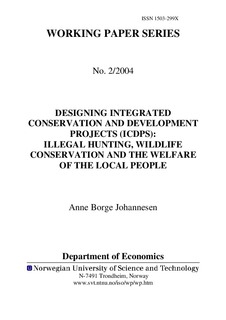| dc.contributor.author | Johannesen, Anne B. | nb_NO |
| dc.date.accessioned | 2014-12-19T14:31:52Z | |
| dc.date.available | 2014-12-19T14:31:52Z | |
| dc.date.created | 2006-10-04 | nb_NO |
| dc.date.issued | 2004 | nb_NO |
| dc.identifier | 126100 | nb_NO |
| dc.identifier.uri | http://hdl.handle.net/11250/267133 | |
| dc.description.abstract | This paper develops a bio-economic model to explore the effect on illegal hunting, wildlife conservation and human welfare of the most common instruments of existing ICDPs. It is demonstrated that stimulating working opportunities in the formal sector has the potential of promoting conservation, while money transfers and distribution of game meat to the local people fail, if not explicitly linked to the conservation objective. The analysis shows that such links, modelled as a risk of being excluded from the project if caught in illegal hunting, may be a more durable mean for ICDPs to reach its goal of improved wildlife conservation and human welfare. The model is illustrated by numerical calculations with data from Serengeti, Tanzania. | nb_NO |
| dc.language | eng | nb_NO |
| dc.publisher | Institutt for samfunnsøkonomi | nb_NO |
| dc.relation.ispartofseries | Working Paper Series, 1503-299X; 2004:2 | nb_NO |
| dc.title | Designing Integrated Conservation and Development Projects (ICDPs): Illegal hunting, wildlife conservation and the welfare of the local people | nb_NO |
| dc.type | Research report | nb_NO |
| dc.contributor.department | Norges teknisk-naturvitenskapelige universitet, Fakultet for samfunnsvitenskap og teknologiledelse, Institutt for samfunnsøkonomi | nb_NO |
